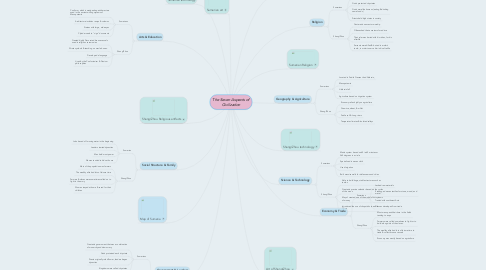
1. Social Structure & Family
1.1. Sumerian
1.1.1. Jobs based off moving water in the beginning
1.1.2. Leaders started dynasties
1.1.3. Men held most power
1.1.4. Women tended to kids at home
1.2. Shang/Zhou
1.2.1. Most of the population was farmers
1.2.2. The wealthy elite had lots of leisure time
1.2.3. Farmers & slaves were sometimes called on to fight in the army
1.2.4. Women stayed at home & cared for their children
2. Government & Leaders
2.1. Sumerians
2.1.1. Created a government that was a combination of monarchy and democracy
2.1.2. Gods protected each city-state
2.1.3. Priests originally ruled Sumer, leaders began dynasties
2.1.4. Kingdoms were called city-states
2.2. Shang/Zhou
2.2.1. Ruled by a strong Monarchy
2.2.2. The king appointed governors to rule distant parts of the kingdom, to keep China in order
2.2.3. King had a large army
2.2.4. Ruled by the Mandate of Heaven
3. Arts & Education
3.1. Sumerians
3.1.1. Cuniform, which is wedge-shaped characters used in the ancient writing systems of Mesopotamia
3.1.2. Architecture includes ramps & columns
3.1.3. Statues with large, wide eyes
3.1.4. Cylinder seals to "sign" documents
3.2. Shang/Zhou
3.2.1. Created highly Decorated bronze vessels used in religious ceremonies.
3.2.2. Wrote symbols & teaching on oracle bones.
3.2.3. Developed a language
3.2.4. Lived by the Confucianism & Daoism philosophies
4. Map of Sumeria
5. Sumerian art
6. Shang/Zhou Religious artifacts
7. Sumerian technology
8. Geography & Agriculture
8.1. Sumerians
8.1.1. Located in Fertile Crescent had little rain,
8.1.2. Mesopotamia
8.1.3. Little rainfall
8.1.4. Agriculture based on irrigation system
8.2. Shang/Zhou
8.2.1. Economy relies highly on agriculture
8.2.2. Grew rice, wheat, & millet
8.2.3. Fertile soil & Long rivers
8.2.4. Temperate climates & Isolated valleys
9. Religion
9.1. Sumerians
9.1.1. Believed in Polytheism
9.1.2. Gods protected city-states
9.1.3. Gods were like humans (eating & drinking same foods)
9.1.4. Priests held high status in society
9.2. Shang/Zhou
9.2.1. Centered on ancestor worship
9.2.2. Often asked their ancestors for advice
9.2.3. Their ruler was buried with his riches, for his afterlife
9.2.4. Servants were killed & buried in a ruler's tomb, in order to serve him in his afterlife
10. Science & Technology
10.1. Sumerians
10.1.1. Made system based on 60 ie 60 minutes or 360 degrees in a circle
10.1.2. Specialized in woven cloth
10.1.3. Used irrigation
10.1.4. Built massive walls for defense around cities
10.2. Shang/Zhou
10.2.1. Able to build huge, stable structures such as tombs
10.2.2. Created a precise calendar based on the cycles of the moon
10.2.3. May of created one of the world's first systems of money
10.2.4. Introduced the use of chopsticks to eat in China
11. Economy & Trade
11.1. Sumerians
11.1.1. Lacked raw materials
11.1.2. Exchanged woven textiles for stone, wood, and metal
11.1.3. Traded with southwest Asia
11.1.4. Classes developed from trade
11.2. Shang/Zhou
11.2.1. Most men spend their time in the fields tending to crops
11.2.2. Farmers were called sometimes to fight or to build along side of the slaves.
11.2.3. The wealthy elite had lots of leisure time to trade & collect bronze vessels
11.2.4. Economy was mostly based on agriculture
